What does local participation in the Holocaust—victims who refer to their murderers by the diminutive versions of their names—teach us about intimacy? About the fragility of the border between good and evil? About what it means to be a human being? For Marci Shore, these are the central questions addressed by Agnieszka Holland’s film In Darkness, Jan Gross‘s and Irena Grudzinska Gross’s book Golden Harvest, and Tadeusz Słobodzianek’s play Our Class. These works reveal the extent to which Poles are coming to see the history of Jews—their lives and their deaths—as a history about themselves, and about all of us.
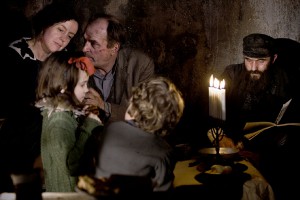 This past April 19, in a place that had once been the Warsaw ghetto, the Museum of the History of Polish Jews opened its doors. The project—involving a 43,000 square foot building and costing over a hundred million dollars—had been well over a decade in the making. Its striking features include the re-created painted ceiling of a 17th century wooden synagogue in the town of Gwoździec. The reconstruction project, spanning seven Polish towns, involved many volunteers working with experts in traditional woodwork and polychrome painting who used only natural pigments. The completed ceiling weighs thirty tons. The intricacies of the designs are breathtaking; the colors are incandescent. April 19 marked the museum’s “soft opening”; the exhibits had not yet been installed. Even so, that first weekend the museum received over 15,000 visitors.
This past April 19, in a place that had once been the Warsaw ghetto, the Museum of the History of Polish Jews opened its doors. The project—involving a 43,000 square foot building and costing over a hundred million dollars—had been well over a decade in the making. Its striking features include the re-created painted ceiling of a 17th century wooden synagogue in the town of Gwoździec. The reconstruction project, spanning seven Polish towns, involved many volunteers working with experts in traditional woodwork and polychrome painting who used only natural pigments. The completed ceiling weighs thirty tons. The intricacies of the designs are breathtaking; the colors are incandescent. April 19 marked the museum’s “soft opening”; the exhibits had not yet been installed. Even so, that first weekend the museum received over 15,000 visitors.
The date of the opening had not been chosen arbitrarily. In autumn 1940 the Germans, having defeated Poland, herded the Jews of Warsaw and the surrounding countryside into a ghetto. They built a wall. Children began to die of cold and disease and hunger. Emaciated bodies lay outside. “In my memories the color of the ghetto is the color of the paper that covered the corpses lying on the street before they were taken away,” wrote Michał Głowiński.
In summer 1942 the Germans sent some 265,040 Jews from the Warsaw ghetto to the gas chambers of Treblinka.
April 19, 1943 was a warm spring day, the temperature reaching in the mid-seventies. That morning the Germans entered the ghetto in two columns to carry out the next deportation. A group of young radicals—some Zionists, some Bundists, some communists—had decided: they would not be taken alive. They fired the first shots in the Warsaw Ghetto Uprising.
In the end the Germans set fire to the ghetto.
Czesław Miłosz, a Polish poet on the other side of the wall, watched the ghetto burn:
Slowly, boring a tunnel, a guardian mole makes his way,
With a small red lamp fastened to his forehead.
He touches buried bodies, counts them, pushes on,
He distinguishes human ashes by their luminous vapor, […]
And he will count me among the helpers of death:
The uncircumcised.
The questions Miłosz raises in the poem titled “A Poor Christian Looks at the Ghetto” have never been resolved. They have, however, in recent years arguably been pushed further in Poland than anywhere else.
*
The story took place in Poland’s eastern provinces, in a small town called Jedwabne in “the backward half of a backward European country.” It was early July in 1941: Hitler’s Germany had just broken the Nazi-Soviet nonaggression treaty and attacked the Soviet Union. The Red Army had retreated and the Wehrmacht had arrived, although the new occupation regime was not yet quite in place. In this small town, caught between two totalitarian occupiers, there opened a window of semi-anarchy. The newly-arrived Germans told the Polish townspeople that they presently had a few days during which they could—in fact, should—take care of the Jews. It began with stonings and lynchings, with murders by farm tools. Later the townspeople forced several dozen of the strongest Jewish men to take down the statue of Lenin erected during the Soviet occupation, and carry the statue to the cemetery, and dig a grave for its burial. The Poles threw the bodies of those Jewish men into the same grave. Germans were there, taking photographs. Then, on the afternoon of July 10, the local Poles forced Jedwabne’s several hundred remaining Jews from their homes and into the town square. The townspeople herded their neighbors into a barn. Then they set the barn on fire.
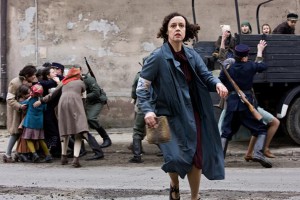 Nearly six decades passed. In May 2000, the historian Jan Tomasz Gross published, in Polish, a short book titled Neighbors: The History of the Extermination of a Jewish Town, which told the story of the Jedwabne massacre. “It is very difficult to describe how great a shock Neighbors was,” Adam Michnik recently wrote. Michnik himself, the editor-in-chief of Poland’s leading newspaper, Gazeta Wyborcza, could not believe the story: for some time, he recalled, “I thought my friend Jan Tomasz Gross had become the victim of a hoax.” For six months after the publication of Neighbors, very little was said. Then one Saturday in November 2000, Gazeta Wyborcza published Jacek Żakowski’s interview with Tomasz Szarota. An historian, Szarota did not doubt the massacre. He asked, though, that readers consider sympathetically the context: a terrorized small town, the local anti-Soviet partisan movement betrayed to the Soviets, the betrayed Polish partisans arrested and murdered by the NKVD, a desire to settle accounts: at the time townspeople had believed that the informer was a local Jew. And there was the ever-present image of “Judeo-Bolshevism,” and the widespread belief that the NKVD—the notorious Stalinist security apparatus—was made up of Jews.
Nearly six decades passed. In May 2000, the historian Jan Tomasz Gross published, in Polish, a short book titled Neighbors: The History of the Extermination of a Jewish Town, which told the story of the Jedwabne massacre. “It is very difficult to describe how great a shock Neighbors was,” Adam Michnik recently wrote. Michnik himself, the editor-in-chief of Poland’s leading newspaper, Gazeta Wyborcza, could not believe the story: for some time, he recalled, “I thought my friend Jan Tomasz Gross had become the victim of a hoax.” For six months after the publication of Neighbors, very little was said. Then one Saturday in November 2000, Gazeta Wyborcza published Jacek Żakowski’s interview with Tomasz Szarota. An historian, Szarota did not doubt the massacre. He asked, though, that readers consider sympathetically the context: a terrorized small town, the local anti-Soviet partisan movement betrayed to the Soviets, the betrayed Polish partisans arrested and murdered by the NKVD, a desire to settle accounts: at the time townspeople had believed that the informer was a local Jew. And there was the ever-present image of “Judeo-Bolshevism,” and the widespread belief that the NKVD—the notorious Stalinist security apparatus—was made up of Jews.
Thus amid the gory details did a theme emerge: the impossibility of disentangling the questions of Poles’ sympathy for anti-semitism and collaboration with the Nazis against the Jews from the questions of Jews’ sympathy for communism, and collaboration with the Soviets against the Poles. “That book is an atomic bomb with a long fuse,” said Szarota’s interviewer Żakowski. It was true. What followed was the most important debate on the Holocaust to take place in Europe since the German Historikerstreit of the 1980s. For Poles, Gross’s Neighbors was a rupture in consciousness.
The journalist Anna Bikont—frustrated by her editor and friend Adam Michnik’s initial resistance to pursuing the story—went to Jedwabne. There she met Marianna Ramotowska, once Rachela Finkelsztejn, who had fled from an analogous massacre in the nearby town of Radziłów, and Stanisław Ramotowski, the Polish man who, in order to save Rachela Finkelsztejn, had made her his wife. Marianna and Stanisław Ramotowski were reluctant to talk. Stanisław told Bikont that yes, it had been the Poles—but that even if he were to know exactly who it was, he would not say. He and Marianna, after all, wanted to be able to live in the place where they were living. “I won’t say,” he added, “how I arranged a marriage ceremony with a priest during the war, when I wanted to marry a Jewess. Even if you were to draw and quarter me, I wouldn’t tell the story. . .” “Don’t say anything, Stasinku,” Marianna interjected. “God forbid. . .” She was grasping his hand.
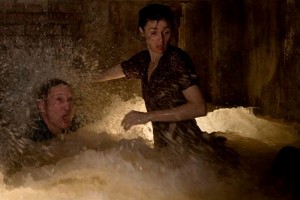 Rachela/Marianna and Stanisław are among the recognizable inspirations for characters in the Polish playwright Tadeusz Słobodzianek’s Our Class, which premiered (in an English translation by Ryan Craig) in the United States in 2011 at the Wilma Theater in Philadelphia. To make a massacre into theater, the theater has to be extraordinary. And this play is extraordinary. Our Class follows ten classmates through three totalitarian occupations, and through the arc of their lives. We are taken into a small Polish town far from any metropolis where everyone knows everyone else. Everyone is unavoidably caught up in everyone else’s lives. We meet adolescents who tease one another and develop crushes on one another and humiliate one another and fantasize about one another. All of the characters are, in Nietzsche’s phrase, “human, all too human.”
Rachela/Marianna and Stanisław are among the recognizable inspirations for characters in the Polish playwright Tadeusz Słobodzianek’s Our Class, which premiered (in an English translation by Ryan Craig) in the United States in 2011 at the Wilma Theater in Philadelphia. To make a massacre into theater, the theater has to be extraordinary. And this play is extraordinary. Our Class follows ten classmates through three totalitarian occupations, and through the arc of their lives. We are taken into a small Polish town far from any metropolis where everyone knows everyone else. Everyone is unavoidably caught up in everyone else’s lives. We meet adolescents who tease one another and develop crushes on one another and humiliate one another and fantasize about one another. All of the characters are, in Nietzsche’s phrase, “human, all too human.”
There are no minor characters. The ensemble cast consists of ten leading roles: self-righteous Heniek is the son of a peasant who works in the fields. He takes Catholicism very seriously and declares his desire to become a firefighter. Jovial Abram wants to be a shoemaker like his father. Instead he is sent by the rabbi to study in America. Serious Rachelka has a talent for foreign languages. Her family owns a mill, but Rachelka wants to become a doctor. Abram is secretly in love with her. Temperamental Zygmunt is a Polish nationalist. His father the bricklayer beats his wife and children; Zygmunt plans to become a soldier. Bumbling Władek, the son of peasant farmers, fantasizes about Rachelka. Beautiful Dora wants to be a film star. Idealistic Jakub wants Abram to stay in Poland and work for social justice there. Son of a merchant, Jakub is a socialist eager to become a teacher and see Jews embrace a socialist revolution alongside their Polish neighbors. Aggressively flirtatious Menachem, a Zionist, tries to seduce Dora. Like Władek, Menachem wants to grow up to be a wagon driver. Sweet Zocha, the daughter of a maid, wants to become a seamstress. She wishes she were the one Menachem would want to take to the movies on his new bicycle. Handsome Rysiek, who aspires to fly airplanes, has a crush on Dora. He sends her a love poem in the shape of a heart. When the others find it, they make fun of him. Dora likes Rysiek, she even likes him a lot, and she feels sorry for his humiliation—but she says nothing when the others mock him.
Heniek, Zygmunt, Władek, Zocha, and Rysiek are Poles. Abram, Rachelka, Dora, Jakub, and Menachem are Jews. In the Wilma Theater’s production directed by Blanka Zizka, all are on stage all the time. We feel the relentlessness of their intimacy, of their dealing with one another. When the play opens, they are all are teenagers—and Polish citizens. The ideological layout of the moment is complex: it is the 1930s and the left is becoming more radical, the right is becoming more radical, the liberal center is melting into air. The traditional Jewish community had long supported Marshal Józef Piłsudski, interwar Poland’s authoritarian dictator, in some sense a kind man, once a socialist, always a Polish patriot —yet one who believed in an inclusive Poland, united by a civic patriotism, an anti-anti-semite. Then, in 1935, came Piłsudski’s death. “Everyone cried. The Jews most of all,” Abram tells us.
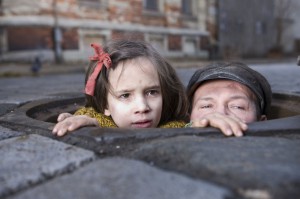 Piłsudski’s death left a vacuum filled by an increasingly anti-semitic nationalist right. Four years later came the Molotov-Ribbentrop Pact, and on September 1, 1939, Nazi Germany invaded Poland from the west. On September 17, the Red Army invaded Poland from the east. The classmates find themselves in the Soviet occupation zone. In the beginning it is not only the Jews who welcome the Red Army: everyone hangs red flags. Zygmunt’s father is the exception: he hangs the red-and-white Polish flag. The Soviets turn the Catholic club into a cinema. Menachem the Zionist becomes a communist, and at the new cinema his classmates listen to him recite Mayakovsky’s poems. Jakub, ever the optimist, is enthusiastic: he encourages his classmates to live, to work, to dance. The NKVD comes quickly for Zygmunt’s father.
Piłsudski’s death left a vacuum filled by an increasingly anti-semitic nationalist right. Four years later came the Molotov-Ribbentrop Pact, and on September 1, 1939, Nazi Germany invaded Poland from the west. On September 17, the Red Army invaded Poland from the east. The classmates find themselves in the Soviet occupation zone. In the beginning it is not only the Jews who welcome the Red Army: everyone hangs red flags. Zygmunt’s father is the exception: he hangs the red-and-white Polish flag. The Soviets turn the Catholic club into a cinema. Menachem the Zionist becomes a communist, and at the new cinema his classmates listen to him recite Mayakovsky’s poems. Jakub, ever the optimist, is enthusiastic: he encourages his classmates to live, to work, to dance. The NKVD comes quickly for Zygmunt’s father.
There are more arrests, and deportations to labor settlements in the Soviet interior. No one is safe. Zygmunt and his mother have to go into hiding. Zygmunt is indignant. He studies the Soviet constitution and finds what he hopes to find: “a son does not answer for his father.” So Zygmunt borrows stationary from the priest and writes a letter to Stalin. A reply comes from Moscow to the local NKVD, which summons Zygmunt. When he arrives, the NKVD officer offers him a cigarette: surely they can come to an understanding.
In this way Zygmunt becomes an NKVD informer—and at once an anti-Soviet partisan. He, together with Rysiek, Heniek, and Wladek, form the underground unit “White Eagle.” Zygmunt betrays his friend Rysiek to the NKVD—after all, he has to betray someone. Heniek and Wladek are too weak: they would break under interrogation. Rysiek is tortured, but remains silent.
In June 1941, Hitler defies the Molotov-Ribbentrop Pact, and Nazi Germany attacks the Soviet Union. Now the Soviets retreat from Jedwabne and the Germans arrive. Rysiek returns home. He knows that one of his friends must have betrayed him to the NKVD; he believes that it was Jakub. Rysiek, Zygmunt, Heniek, and—less enthusiastically—Wladek find Jakub. It is Zygmunt who tears the first stake from a neighbor’s fence, and the others follow. With these stakes they beat Jakub to death. Zygmunt is perhaps especially vicious to cover his own guilt. His anger at Jakub, we sense, is also his self-disgust: for having succumbed, for having collaborated. After beating Jakub to death, Zygmunt, Heniek, and Rysiek come for Dora. Menachem, by now Dora’s husband, has already fled; Dora is home alone with their baby. Rysiek rapes her first.
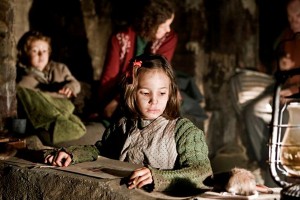 We soon see Dora again. It is July 10, 1941, a hot summer day. Dora, together with the other Jews, is forced to weed the town square with a spoon, holding her baby, who is crying for milk. Dora cannot give her any; she is desperate for water for herself. She sees Zocha, calls to her, asks Zocha to bring water, pleads with her to take the baby. Zocha wavers, but in the end what can she do? She cannot bring home to her older husband someone else’s baby—a Jewish baby no less. Zocha flees, distraught. It is Dora’s neighbors, her classmates Heniek and Zygmunt and Rysiek who once sent her a love poem, who herd her and the baby into the barn. It is they who set the barn on fire. “I knew all of them,” Dora says. Inside the barn there is not enough air; it is unbearably hot. Dora smells gasoline. She begins to cough, to suffocate, to vomit. She drops her baby.
We soon see Dora again. It is July 10, 1941, a hot summer day. Dora, together with the other Jews, is forced to weed the town square with a spoon, holding her baby, who is crying for milk. Dora cannot give her any; she is desperate for water for herself. She sees Zocha, calls to her, asks Zocha to bring water, pleads with her to take the baby. Zocha wavers, but in the end what can she do? She cannot bring home to her older husband someone else’s baby—a Jewish baby no less. Zocha flees, distraught. It is Dora’s neighbors, her classmates Heniek and Zygmunt and Rysiek who once sent her a love poem, who herd her and the baby into the barn. It is they who set the barn on fire. “I knew all of them,” Dora says. Inside the barn there is not enough air; it is unbearably hot. Dora smells gasoline. She begins to cough, to suffocate, to vomit. She drops her baby.
Menachem survives, hidden by Zocha in secret from her husband. Rachelka survives, hidden by Wladek in secret from his mother. Wladek arranges for her baptism, and for their wedding. Rachelka becomes Marianna. Their wedding is attended by their classmates who murdered their other classmates. Among the wedding gifts is a tablecloth, which Zocha’s husband has taken from Rachelka’s own home after Rachelka’s mother and sisters burned to death in the barn.
*
Rachelka’s tablecloth is in essence the point of departure for Jan Gross’s most recent book, co-authored with Irena Grudzinska Gross and titled Golden Harvest. The book is not a monograph; it is, rather, an essay reflecting upon the meaning of that stolen tablecloth. These reflections must be understood as the next words spoken in an ongoing conversation. Thirteen years ago, Neighbors was a self-conscious provocation, directed at Gross’s own friends and colleagues: how could they have left this material untouched for so long? Now, in large part because of Neighbors, the situation is a very different one. In 2003, a group of scholars, including Barbara Engelking, Jan Grabowski, Jacek Leociak and Dariusz Libionka, came together to found the Polish Center for Holocaust Research. Several of these same scholars have played key roles in the development of the Museum of the History of Polish Jews. It is the extensive research done by themselves and other Polish colleagues that inspires—and makes possible (as Gross and Grudzinska Gross very much acknowledge)—the reflections in Golden Harvest.
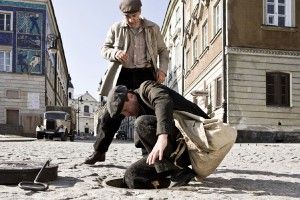 The book opens with a macabre gold rush. A photograph (the object of much controversy in Poland) sets the scene: some two dozen peasants posed in a semi-circle with their farm tools, standing on what seems to be dry, barren earth, a collection of skulls and bones lying before them. A handful of militiamen look on; all appear to be relaxed. “We are in the middle of Europe right after World War II,” the authors remind us. “The peasants in the photograph are standing atop a mountain of ashes. These are the ashes of 800,000 Jews gassed and cremated in the Treblinka extermination camp between July 1942 and October 1943. The peasants have been digging through the remains of Holocaust victims, hoping to find gold. . .”
The book opens with a macabre gold rush. A photograph (the object of much controversy in Poland) sets the scene: some two dozen peasants posed in a semi-circle with their farm tools, standing on what seems to be dry, barren earth, a collection of skulls and bones lying before them. A handful of militiamen look on; all appear to be relaxed. “We are in the middle of Europe right after World War II,” the authors remind us. “The peasants in the photograph are standing atop a mountain of ashes. These are the ashes of 800,000 Jews gassed and cremated in the Treblinka extermination camp between July 1942 and October 1943. The peasants have been digging through the remains of Holocaust victims, hoping to find gold. . .”
In 1945, Polish peasants were digging for gold in Treblinka: what does this tell us—the authors ask—about history, about those peasants, about ourselves? In part this question has its context in intellectual autobiography, in particular Gross’s lifelong preoccupation with human behavior under totalitarianism, both Nazi and Soviet. His work of the past two decades has been preoccupied more specifically with questions of local, non-German participation in the Holocaust, with the role of improvisation and spontaneity in the atrocities. How many of the Polish Jews killed during the Holocaust were killed directly or indirectly (through denunciation, for instance) by their Polish neighbors—tens of thousands, hundreds of thousands? The authors recognize that however large that unknown and unknowable number is, it is a number marginal to the scale of the Holocaust as a whole. They know that their topic lies, in their own words, on “the periphery of the Holocaust.” It is precisely this “periphery” that they find most morally troubling.
What haunts them is not only the actions themselves, but also the extent to which these actions met with social approval. The local people under German occupation, the authors observe, were not ashamed of how they acted: on the contrary, it was hiding Jews from the Germans that failed to meet with social approval. Not only plunder, but also killing no longer violated norms. After all, killings took place in public. The behavior of Zocha’s husband, who loots the tablecloth from Rachelka’s own home, was sanctioned by his own community.
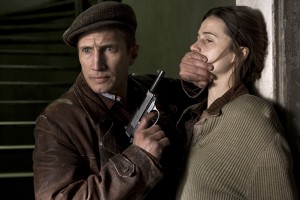 Gross and Grudzinska Gross’s concern with social approval, with what was deviant and what was normative, is reflected as well in their struggle with the historical sources, which are incomplete, partial, anecdotal. So much could not be expressed. How then, can we move from the particular to the general — from the singular impressionistic account to an understanding of how society functioned as a whole? Here the authors turn to cultural anthropology, and in particular to Clifford Geertz’s method of “thick description”: they attend not only to the description of actions, but also to their meanings. Geertz’s method is based on the conviction that culture is semiotic; it is a system of signs that demands interpretation. This is what the Gross and Grudzinka Gross attempt to do in Golden Harvest. “The peasants from Treblinka,” they write, “are looking at us, not at the bones. They are not looking as if to say ‘I have nothing to do with it,’ but to say ‘Nothing is going on.’ They look innocent.” This reading is unsettling, and not only because one senses it could reveal the truth. It is unsettling, too, because it suggests a larger problem of interpretation: the most haunting questions are those whose answers will forever lie beyond the limits of our knowledge. Can we ever truly penetrate the consciousness of another human being?
Gross and Grudzinska Gross’s concern with social approval, with what was deviant and what was normative, is reflected as well in their struggle with the historical sources, which are incomplete, partial, anecdotal. So much could not be expressed. How then, can we move from the particular to the general — from the singular impressionistic account to an understanding of how society functioned as a whole? Here the authors turn to cultural anthropology, and in particular to Clifford Geertz’s method of “thick description”: they attend not only to the description of actions, but also to their meanings. Geertz’s method is based on the conviction that culture is semiotic; it is a system of signs that demands interpretation. This is what the Gross and Grudzinka Gross attempt to do in Golden Harvest. “The peasants from Treblinka,” they write, “are looking at us, not at the bones. They are not looking as if to say ‘I have nothing to do with it,’ but to say ‘Nothing is going on.’ They look innocent.” This reading is unsettling, and not only because one senses it could reveal the truth. It is unsettling, too, because it suggests a larger problem of interpretation: the most haunting questions are those whose answers will forever lie beyond the limits of our knowledge. Can we ever truly penetrate the consciousness of another human being?
The moral imperative the authors feel is the imperative to understand that which cannot fully be expressed in the sources, that which we cringe before understanding. They are, in this sense, epistemological optimists: they are searching for clarity about the nature of human evil and human weakness, believing, contra spem spero, that there are answers to be found, that meaning and understanding are possible. “Life experience,” they write, “suggests that what actually happens usually has (some) meaning, that life is not a sequence of utterly random social interactions independent of one another, the way lottery numbers sequentially drawn make a winning series. Between what happened moments before and a few minutes after there is some connection.” Gross, originally trained as a sociologist, is a professor of history. Grudzinska Gross, a philologist by education, is a literary scholar. Yet the reader feels in this book how the tools of all these disciplines begin to feel inadequate to the authors—hence their anthropological turn. They continually revisit certain jolting visual images: clothing ripped from corpses (and sometimes from the “deceased on leave,” in Emmanuel Ringelblum’s expression, awaiting the gas chambers), bones, skulls, gold-filled bloody teeth torn from gums. These recurring images suggest not only greed and desecration, but also the intermingling of life and death, the spiritual and the material, the sacred and the profane. What happens when these realms cease to be distinct?
While the authors do not pursue this point further, they point in the direction of a cultural anthropology that focuses on the effacing of boundaries: Claude Lévi-Strauss and René Girard both describe cultural crisis as being generated by a lack of differentiation, drawing attention to how numerous myths begin with a state of affairs in which there is no longer a distinction between heaven and earth, humans and beasts, the pure and the impure. Differentiation, the Girardian scholar Robert Hamerton-Kelly has observed, is “culture’s supporting skeleton.” In Golden Harvest, the disintegration of cultural order through the mixing of sacred and profane is symbolized in a passage about the latrine area in Bel?ec: after the war, this was an especially fertile spot for gold-digging, as Jews sometimes threw valuables into the latrines rather than give them to the Germans. The local people digging found not only gold, but also small skeletons—the corpses of children presumably drowned in the latrines by the camp guards.
*
Golden Harvest raises at least three related questions. First, should we allow our reflections about torture and murder to “bleed into” reflections about plunder and desecration? How should we maintain the moral distinctions among killing Jews with one’s own hands, turning them over to the Germans for a reward, and digging for their gold teeth in Treblinka? Second, when, if ever, is the greed motivating plunder and desecration justified by poverty, by the struggle for survival? And third, as we gain a clearer picture of what was done, how can we attribute causality to actions? We know that the elimination of the Jews created a space for the socio-economic upward mobility of their Polish neighbors. “Objectively” (to draw upon an infamous communist distinction), local Poles often benefitted from the murder of the Jews. But how can we determine the “subjective” motivations for their actions? To what extent was plunder driven by social resentment and anti-semitism, by opportunism and greed, by desperation? How can we delineate the borders between hostility, indifference, and despair?
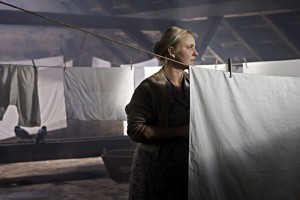 This impossibility of knowing to the end what is going on inside another person’s soul raises another aspect of the totalitarian experience that has long been central to Gross’s work: the question of intimacy. To return to Rachelka’s tablecloth: the authors of Golden Harvest are haunted by the intimacy revealed by local participation in the Holocaust, by accounts of victims who refer to their murderers by the diminutive versions of their names. When Jewish survivors speak about this period they often recall the locals—be they Poles, Ukrainians, Lithuanians or others—as being “worse than the Germans.” Gross and Grudzinska Gross speculate that this is not because local participants in the Holocaust were “objectively” worse than the German perpetrators, but rather because “death administered by people well known to the victims evoked special suffering, as they must have also felt betrayed.”
This impossibility of knowing to the end what is going on inside another person’s soul raises another aspect of the totalitarian experience that has long been central to Gross’s work: the question of intimacy. To return to Rachelka’s tablecloth: the authors of Golden Harvest are haunted by the intimacy revealed by local participation in the Holocaust, by accounts of victims who refer to their murderers by the diminutive versions of their names. When Jewish survivors speak about this period they often recall the locals—be they Poles, Ukrainians, Lithuanians or others—as being “worse than the Germans.” Gross and Grudzinska Gross speculate that this is not because local participants in the Holocaust were “objectively” worse than the German perpetrators, but rather because “death administered by people well known to the victims evoked special suffering, as they must have also felt betrayed.”
The play inspired by Gross’s Jedwabne book illuminates in particular this dimension of the victims’ experience. Our Class is the antithesis of so many accounts of the Holocaust: it is not at all about anonymous bureaucratic murder in what Hannah Arendt calls “factories to produce corpses.” It is rather about the drama of youth, set against two totalitarian hells. The protagonists all have complicated friendships and romances and rivalries with one another. We see the “innocent” cruelties of schoolchildren, their simultaneous attractions and resentments. We see what Freud insisted upon: in the absence of the repressive force of civilization, what drives us is Eros and Thanatos. These characters act out of ambiguous motives, in which the political-ideological and the spontaneous-emotional are entangled. No one emerges with clean hands. Long before he wrote Neighbors, in studying Poland under Soviet occupation, Gross was already struck by the countless cases in which victim and perpetrator knew one another personally. Mechanisms of terror were used to settle personal scores; the ever-present possibility of informing meant that every person was threatened at every moment. One’s life tended to lie in the hands of one’s friends and acquaintances. “Although the distinction between private and public realm is indeed obliterated under totalitarianism,” Gross writes in Revolution from Abroad: The Soviet Conquest of Poland’s Western Ukraine and Western Belarus, “this occurs not because of the confiscation of the private realm by the state but primarily because of the privatization of the public realm.”
After a recent lecture by Gross titled “On the Periphery of the Holocaust: Killing and Plunder of Jews by their Neighbors”, the Polish-Jewish émigré Alexander Schenker, a professor emeritus of linguistics at Yale, had a question. Why, he asked Gross, do you find the fact that neighbors killed neighbors so shocking? After all, whom do you hate if not your neighbors? Schenker’s view echoes in some way philosopher Jay Bernstein’s reading of Hegel’s master-slave dialectic: namely, what we cannot bear about our lives is all the levels of our dependencies on others. It is no accident that most murders are domestic—why would you want to kill a stranger? You want to kill the other whose closeness binds you.
The discussion that Gross opened with Neighbors, and which continues in Słobodzianek’s Our Class and in Golden Harvest, is not only about brutalization and cruelty. It is also about intimacy. The deaths in Our Class are not impersonal deaths: the protagonists use the diminutized versions of one another’s names. In this play killing is intersubjective; death is solitary, and both are intimate. In The Origins of Totalitarianism, Arendt argued that in totalitarian systems subjectivity was extinguished before physical death. Here following Arendt, the authors of Golden Harvest, insist upon the Kantian point that “[a] person’s irreducible subjectivity is a value in itself, and any instrumentalizing of a human being is an abuse.” They want to restore the subjectivity that Arendt tells us was destroyed, a restoration demanding recognition of the singularity of each death. This restoration is not redemption. The authors understand the restoration of subjectivity only as a step towards living in truth. In breaking the silence that surrounded their own childhoods, they see a hope for healing. The experience of the victims of the Holocaust, they write, “was and remains in great measure inexpressible, because pain and physical violence destroy language and cause a reversion to a state anterior to language. Still, trauma demands to be expressed. What is horrific remains horrific so long as it is not named. Once a name is attached to it, the horror retreats; it diminishes, since the very act of naming reconnects the victim to the world.”
Yet is this the case? Can such a restoration of subjectivity—and with it the most intimate human experience—effect the receding of horror? No, Agnieszka Holland answers in her film In Darkness (W ciemności). In Darkness is set in Lvov (once Habsburg Lemberg, then Polish Lwów, later Soviet Lvov, today Ukrainian L’viv) in 1943 and 1944, during the German occupation that immediately followed the Stalinist one. David F. Shamoon’s screenplay is based closely on a true story. German-occupied Lvov was a brutalized city, habituated to terror, in which those remaining alive have a seeming desire to survive even in hell. In 1942, the Germans began deporting the ghetto’s Jewish inhabitants to the Janowska camp for forced labor or to Belzec for extermination. In June 1943, the Germans liquidated the ghetto; locals often looted it. A handful of Jews escaped deportation and went into hiding. Germans, as the film portrays, were paying local informants a reward for each discovered Jew.
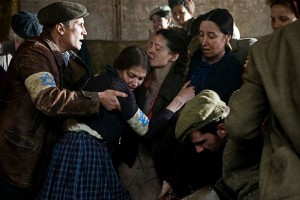 For the leading role of Leopold (“Poldek”) Socha, Holland chose the Polish actor Robert Więckiewicz, whose performance in this film is astounding. During the German occupation of his city, the Polish Poldek, a former thief, is earning money as a sewer worker. Bortnik, Poldek’s Ukrainian friend from their shared time in prison, has become an officer, a so-called “blue policeman” working for the Germans. They are two among a motley crew of characters: Poles, Germans, Jews, Ukrainians, divided by religion and class and ethnicity and language. The Jews themselves are divided by class and religiosity and language: some speak Yiddish, some Polish, some German. Poldek will attempt to exploit the hell of the German occupation to make a profit: for a large price, he will find a hiding place for a handful of Jews inside the sewers.
For the leading role of Leopold (“Poldek”) Socha, Holland chose the Polish actor Robert Więckiewicz, whose performance in this film is astounding. During the German occupation of his city, the Polish Poldek, a former thief, is earning money as a sewer worker. Bortnik, Poldek’s Ukrainian friend from their shared time in prison, has become an officer, a so-called “blue policeman” working for the Germans. They are two among a motley crew of characters: Poles, Germans, Jews, Ukrainians, divided by religion and class and ethnicity and language. The Jews themselves are divided by class and religiosity and language: some speak Yiddish, some Polish, some German. Poldek will attempt to exploit the hell of the German occupation to make a profit: for a large price, he will find a hiding place for a handful of Jews inside the sewers.
Janek, who abandons his wife and daughter to flee the ghetto with his lover Chaja; the once wealthy couple Ignacy and Paulina, who try desperately to protect their two small children, Krystyna and Pawelek; the orphaned Klara, whose sister runs away from her to return to certain death in the ghetto; and Mundek, who is falling in love with Klara – these are some of the people who descend into the sewers. They descend into a life in darkness, into a life among slime and filth and rats—rats so vivid that they almost become characters themselves.
This labyrinthine underworld is not unfamiliar to Poles: the story of the Polish—and Polish-Jewish—resistance to German occupation is inseparable from the sewers. In 1957, the Polish director (and Holland’s mentor) Andrzej Wajda released the now legendary Kanał (“Canal”), a historical drama of Polish resistance fighters attempting to escape the Germans in late September 1944, during the last days of the Warsaw Uprising. “Watch them closely,” the narrator instructs the viewer as the film begins, “for these are the last hours of their lives.” Wajda shot the film in black-and-white. The claustrophobia is merciless.
The sewers were a central setting for the drama not only of those who fought in the Warsaw Uprising of 1944, but also of those who fought in the Warsaw Ghetto Uprising of 1943. “The only way out was the sewers,” Marek Edelman, one of the commanders of the Jewish revolt, testified in 1951 at the trial of SS Generals Jürgen Stroop and Franz Konrad. In the spring of 1943, after Stroop and his men set fire to the ghetto, Edelman led the last surviving ghetto fighters in escaping through the sewers. Inside the water reeked of feces and methane. They were trapped there for days. Some of them suffocated. Symcha Ratazjer-Rotem, who survived to tell the story, returned to Warsaw from Jerusalem for the 70th anniversary of the Warsaw Ghetto Uprising. On April 19 Polish President Bronislaw Komorowski decorated him with the Grand Cross of the Order of the Rebirth of Poland (Krzyż Wielki Orderu Odrodzenia Polski). Edelman, who also survived to tell the story, died in October 2009. Holland’s film is dedicated to him.
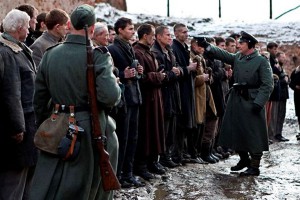 In In Darkness, Holland does nothing to attenuate the excruciating feeling of being ensconced in the sewers among the rats. What she wanted was to make a film “free of artificiality, of kitsch.” Against the wishes of the producers, Holland refused to make the film in English, insisting on filming in all of the original languages: Polish, Yiddish, Ukrainian and German. Necessarily lost in the English subtitles are the subtle ways in which class, ethnicity, power, and status are revealed in the languages themselves. The result is a film that is startlingly unmediated. “We wanted the audience to have the sensual feeling of being there,” Holland said during an interview. She and her cast and crew succeed—which is why the film is nearly unbearable to watch. In its naked brutality In Darkness recalls Tadeusz Borowski’s Auschwitz stories. The most famous, “This Way for the Gas, Ladies and Gentlemen,” includes a scene in which a young, pretty Jewish woman arrives in Auschwitz on a transport. She does not want to go to the gas chambers; she wants to be among those who are selected, if only for a time, to remain alive. Her small child runs after her, but he cannot keep up, his mother is walking very quickly away from him. The mother denies the child; she wants to live. “Mama, mama, don’t run away!” the child calls desperately. Not long after writing this, Borowski, a Polish Auschwitz survivor, gassed himself in his Warsaw apartment. He was twenty-nine years old. His stories are arguably the best ever written about Auschwitz. I used to teach them in my undergraduate seminars. After I gave birth to my son, I no longer could.
In In Darkness, Holland does nothing to attenuate the excruciating feeling of being ensconced in the sewers among the rats. What she wanted was to make a film “free of artificiality, of kitsch.” Against the wishes of the producers, Holland refused to make the film in English, insisting on filming in all of the original languages: Polish, Yiddish, Ukrainian and German. Necessarily lost in the English subtitles are the subtle ways in which class, ethnicity, power, and status are revealed in the languages themselves. The result is a film that is startlingly unmediated. “We wanted the audience to have the sensual feeling of being there,” Holland said during an interview. She and her cast and crew succeed—which is why the film is nearly unbearable to watch. In its naked brutality In Darkness recalls Tadeusz Borowski’s Auschwitz stories. The most famous, “This Way for the Gas, Ladies and Gentlemen,” includes a scene in which a young, pretty Jewish woman arrives in Auschwitz on a transport. She does not want to go to the gas chambers; she wants to be among those who are selected, if only for a time, to remain alive. Her small child runs after her, but he cannot keep up, his mother is walking very quickly away from him. The mother denies the child; she wants to live. “Mama, mama, don’t run away!” the child calls desperately. Not long after writing this, Borowski, a Polish Auschwitz survivor, gassed himself in his Warsaw apartment. He was twenty-nine years old. His stories are arguably the best ever written about Auschwitz. I used to teach them in my undergraduate seminars. After I gave birth to my son, I no longer could.
In writing the script, Shamoon made the decision that he “would not sugar-coat any of the Jewish characters—they were all deeply flawed.” This was equally true of the non-Jewish characters. Poldek, the emergent hero, was a criminal even before two totalitarian occupations dissolved social norms. His story is one of countless stories which teach us that, for better or for worse, we cannot predict how people will behave in extreme circumstances. The real-life Rabbi Jacob Baker, who, like Abram Baker in Our Class, emigrated to the United States in the late 1930s, lived to see the publication of Gross’s Neighbors. In 2001, the then eighty-seven year-old man gave an interview to the Polish press. “Even Jurek Laudanski,” Rabbi Baker said, “one of the main murderers. . .as a young boy was very nice. I remember him well, we lived not far from each other and we talked often about religion, because he wanted to be a priest, and I was studying Talmud.”
Poldek, one suspects, was never “very nice.” His pseudonym is Korsarz, “the pirate.” Upon encountering these desperate Jews attempting to escape from the ghetto, Poldek’s first thought is how he can best make a profit from them. His feelings change very, very gradually—in ways and for reasons that he himself does not fully understand. What role does money play? Is Poldek motivated by antisemitism, by altruism, by greed? By a desire to take care of his wife? To impress her with jewels—or with heroism? Is he sacrificing himself for these people, or exploiting them, or neither or both? Like Zocha in Our Class, who presents Rachelka with the tablecloth that Zocha’s husband has plundered from Rachelka’s own home, Poldek and the other protagonists in Holland’s film are characters of moral ambiguity. They find themselves in a world where there are no innocent choices and no morally comfortable places. This film is about “Grenzerfahrungen,” that is—in Holland’s words—about “border human experience,” about “showing and feeling how fragile is the border between good and bad, how you can slip on one side or other in one minute. . .”
Like both Słobodzianek and Holland, Gross and Grudzinska Gross approach their subject with no moral arrogance. They, too, feel painfully the fragility of that border between good and evil, and how easily one can slip. Poles, we now know from the work of Gross and others, were not as innocent during the Holocaust as they long liked to believe. Yet he and Grudzinska Gross make clear that looting, denunciation, barbarism, and betrayal were not unique to Poles during the Holocaust; reflections upon Rwanda, Cambodia, and Bosnia appear throughout their book. Their most profound questions are universal ones. Holland, although not an epistemological optimist about finding answers, feels the same universalist moral imperative. In Darkness, she explains, poses the questions: What does it mean to be a human being? What are we like? What are we capable of? Like Holland, Gross and Grudzinska Gross invoke the first-personal plural. They want to know what this savage history says about us. A closely related sentiment has animated the project of the Museum of the History of Polish Jews since its inception: the history of Jews—their lives and their deaths—is a history about us. And so this deeply self-reflective book ends with this disquieting thought: “This is why the photograph of Treblinka’s peasants—also, undoubtedly, ‘normal, ordinary, hardworking, religious, and possessing a whole array of virtues’—in addition to evoking disgust, is so frightening: we cannot know for sure that it will not one day be pulled from our own family album.”
Marci Shore is Associate Professor of History at Yale University and presently a Visiting Fellow at the Institute for Human Sciences (IWM) in Vienna. She is the author, most recently, of The Taste of Ashes: The Afterlife of Totalitarianism in Eastern Europe.
© Author / Transit 2013
© Photos: Jasmin M Dichant ©SCHMIDTz KATZE FILMKOLLEKTIV-ZEBRA Film Studio-The Film Works 2011